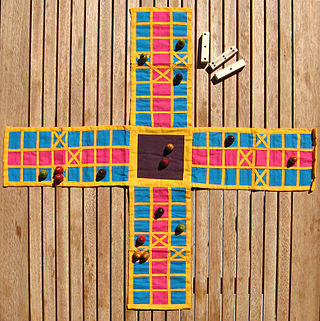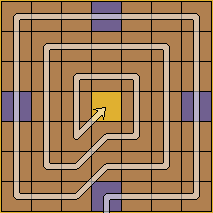
Ludo is a strategy board game for two to four players, in which the players race their four tokens from start to finish according to the rolls of a single die. Like other cross and circle games, Ludo is derived from the Indian game Pachisi. The game and its variations are popular in many countries and under various names.

Mancala refers to a family of two-player turn-based strategy board games played with small stones, beans, or seeds and rows of holes or pits in the earth, a board or other playing surface. The objective is usually to capture all or some set of the opponent's pieces.

Pachisi is a cross and circle board game that originated in Ancient India. It is described in the ancient text Mahabharata under the name of "Pasha". It is played on a board shaped like a symmetrical cross. A player's pieces move around the board based upon a throw of six or seven cowrie shells, with the number of shells resting with the aperture upward indicating the number of spaces to move.

Robert Stewart Culin was an American ethnographer and author interested in games, art and dress. Culin played a major role in the development of ethnography, first concentrating his efforts on studying the Asian-Americans workers in Philadelphia. His first published works were "The Practice of Medicine by the Chinese in America" and "China in America: A study in the social life of the Chinese in the eastern cities of the United States", both dated 1887. He believed that similarity in gaming demonstrated similarity and contact among cultures across the world.

Ashta-kashte is a race board game from Bengal akin to the Cross and Circle family for two to four players originating in India. Although there is no evidence for that, it is considered by some as the direct ancestor of Pachisi. It is played on a board with a 7-by-7 grid on it. It is similar to Chowka bhara, or to Ashtam changam pe where there is a 5-by-5 grid on the board.
Cross and circle is a board game design used for race games played throughout the world.

Mensch ärgere Dich nicht is a German board game, developed by Josef Friedrich Schmidt in 1907/1908. Some 70 million copies have been sold since its introduction in 1914 and it is played in many European countries.

Chaturaji is a four-player chess-like game. It was first described in detail c. 1030 by Al-Biruni in his book India. Originally, this was a game of chance: the pieces to be moved were decided by rolling two dice. A diceless variant of the game was still played in India at the close of the 19th century.

Long dice are dice, often roughly right prisms or antiprisms, designed to land on any of several marked lateral faces, but neither end. Landing on end may be rendered very rare simply by their small size relative to the faces, by the instability implicit in the height of the dice, and by rolling the long dice along their axes rather than tossing. Many long dice provide further insurance against landing on end by giving the ends a rounded or peaked shape, rendering such an outcome physically impossible.

Bul is a running-fight board game originating in Mesoamerica, and is known particularly among several of the Maya peoples of Belize and the Guatemalan highlands. It is uncertain whether this game dates back to the pre-Columbian Maya civilization, or whether it developed in the post-colonial era after the arrival of the Spanish conquistadores.
Rimau-rimau is a two-player abstract strategy board game that belongs to the hunt game family. This family includes games like bagh-chal, main tapal empat, aadu puli attam, catch the hare, sua ghin gnua, the fox games, buga-shadara, and many more. Rimau-rimau is the plural of rimau which is an abbreviation of the word harimau, meaning 'tiger' in the Malay language. Therefore, rimau-rimau means 'tigers'. The several hunters attempting to surround and immobilize the tigers are called orang-orang, which is the plural of orang, meaning 'man'. Therefore, orang-orang means 'men' and there are twenty-two or twenty-four of them, depending on which version of the game is played. The game originates from Malaysia.

Awithlaknakwe is a strategy board game from the Zuni Native American Indians of the American Southwest. The board contains 168 squares with diagonal grids. Two or four may play, with players identified as North, West, South, and East.
Catch the hare is a two-player abstract strategy board game from Europe, and perhaps specifically from Spain. It is a hunt game, and since it uses a standard alquerque board from the game alquerque de doze, it is specifically a tiger hunt game. In some variants, some or all of the diagonal lines are missing which makes it difficult to classify as a tiger game in general. One hare is going up against ten to twelve opponents(hunters or hounds). The hare is the "tiger" in this hunt game which is prey and predator at the same time. The hare can capture the opponents by leaping over them. The opponents attempt to surround and trap the hare.
Tûkvnanawöpi is a two-player abstract strategy board game played by the Hopi native American Indians of Arizona, United States. The game was traditionally played on a slab of stone, and the board pattern etched on it. Tukvnanawopi resembles draughts and Alquerque. Each player attempts to capture each other's pieces by hopping over them. It is unknown how old the game is; however, the game was published as early as 1907 in Stewart Culin's book "Games of the North American Indians Volume 2: Games of Skill".
Tuknanavuhpi' is a two-player abstract strategy board game played by the Hopi Native American Indians of Arizona, United States. It is also played in many parts of Mexico. The game was traditionally played on a slab of stone with the board pattern etched on it. Tukvnanawopi resembles draughts and Alquerque. Players attempt to capture each other's pieces by hopping over them. It is not known when the game was first played; however, the game was published as early as 1907 in Stewart Culin's book Games of the North American Indians Volume 2: Games of Skill.
Awithlaknannai Mosona is a two-player strategy board game from the Zuni Native American Indian tribe of New Mexico, United States. It is unknown how old the game is. The game was described by Stewart Culin in his book "Games of the North American Indians Volume 2: Games of Skill" (1907). In this book, it was named Awithlaknan Mosona. Awithlaknannai Mosona resembles another Zuni board game called Kolowis Awithlaknannai with few minor differences. The former having a smaller board, and depending upon the variant, it also has less lines joining the intersection points. The rules are the same. Awithlaknannai Mosona belongs to the draughts and alquerque family of games as pieces hop over one another when capturing. It is actually more related to Alquerque, since the board is made up of intersection points and lines connecting them. It is thought that the Spanish had brought Alquerque to the American Southwest, and Awithlaknannai Mosona may have been an evolution from Alquerque. However, in Stewart Culin's 1907 book, the Zunis claim that they had adopted a hunt game from Mexico similar to catch the hare and the fox games of Europe, and transformed it into Awithlaknannai Mosona. In these games, one player has more pieces over the other, however, the other player's piece has more powers. The Zuni's equalized the numbers of pieces and their powers, and also may have transformed the board making its length far exceed its width. Diagonal lines also replaced orthogonal lines altogether. However, the hunt game from Mexico may have used an alquerque board even though the game mechanics of their new game, Awithlaknannai Mosona, were completely different.
Indian and jackrabbits is a two-player abstract strategy board game from the Tiwa tribe of Taos, New Mexico. A similar game with a slightly different board is also played by the Tohono O'odham tribe of Arizona. From the outset, these games look like hunt games similar to catch the hare, the fox games of Europe, and the tiger and leopard games of Asia, because they use very similar boards, and the game mechanics are the same, and the number of pieces each player controls is different. However, they are not the same games, because the goals are completely different. The goal of the one Indian is to capture just one of the twelve jackrabbits. The goal of the jackrabbits is to move themselves safely onto the other side of the board mirroring their initial positions.
Sua ghin gnua is a two-player abstract strategy board game from Thailand, formerly known as Siam. Another name for the game is tigers and oxen. It is a hunt game played on a 5x5 square grid with only orthogonal lines. One player plays the three tigers, and the other player plays the twelve oxen. The board is empty in the beginning. Players first drop their pieces onto the board, and then are able to move them. The tigers can capture the oxen by the short leap as in draughts and alquerque, but the oxen attempt to elude and at the same time hem in the tiger. Sua Ghin Gnua most resembles the tiger hunt games such as bagh-chal, rimau-rimau, main tapal empat, catch the hare, and adugo since they all use a 5 x 5 square grid. But tiger games technically consist of a standard alquerque board which is a 5 x 5 square grid with several diagonal lines criss-crossing through it which are completely missing in sua ghin gnua. There are however some variants of catch the hare which have missing diagonal lines also. Another game that resembles sua ghin gnua is from Myanmar, called tiger and buffaloes, which is a hunt game consisting of a 4 x 4 square grid with no diagonal lines. Myanmar happens to border Thailand geographically so there might be a historical connection between the two games. Another game from Myanmar is lay gwet kyah that is presumed to be similar to sua ghin gnua. Sua ghin gnua was briefly described by Stewart Culin, in his book Chess and Playing Cards: Catalogue of Games and Implements for Divination Exhibited by the United States National Museum in Connection with the Department of Archaeology and Paleontology of the University of Pennsylvania at the Cotton States and International Exposition, Atlanta, Georgia 1895 (1898). It's also briefly mentioned by H.J.R. Murray in his book A History of Chess (1913). It was also described by R.C. Bell, in his book Board and Table Games from Many Civilizations (1969).

Zohn Ahl is a roll-and-move board game played by the Kiowa Indians of North America. It is often cited as a typical representative of many similar Native American games. It is often equated with Tsoñä, also played by the Kiowa.
La'b Madjnuni, also known as Crazy Game, is a mancala game played in Damascus (Syria) in the late 19th century.











